|
HOME: www.hiltonpond.org |
|||
|
THIS WEEK at HILTON POND
23-31 May 2011 Installment #512---Visitor # (Back to Preceding Week; on to Next Week) |
|
SPRING FANCY:
IT'S ALL ABOUT PASSING THE GENES "In the spring a young man's fancy lightly turns to thoughts of love." So wrote Alfred, Lord Tennyson--poet laureate of the United Kingdom during the Victorian era. He was right, except for one thing: The fancy of most young men we know turns HEAVILY to love--not lightly--when the calendar flips from winter to spring, and they may have more than platonic relationships on their minds. We don't suppose other organisms think about "love" when spring is in the air, but if observations this week at Hilton Pond Center are any indication the birds and the bees and even the trees are at least intent on reproduction and passing their genes to the next generation.
All text, maps & photos © Hilton Pond Center The first sign that spring hormones are still raging came when we almost stepped on a female Painted Turtle, Chrysemys picta, not 30 feet outside our office window in the Center's old farmhouse. As we were checking mist nets for birds, we happened to look down and noticed the dark, smooth-shelled reptile--with a muddy hole in the ground at the posterior end of her carapace. This turtle was hard at work; she'd already moistened and softened hard clay soil with her urine and excavated a vase-shaped cavity in which we already could see one oval-shaped white egg (above)--still glistening from just having passed through her cloaca.
All text, maps & photos © Hilton Pond Center We slowly backed off and went inside to get our camera, returning to find the turtle intent on finishing her clutch. (We're always careful when we encounter nesting turtles; too much activity can cause them to abandon egg-laying and retreat to the safety of the pond.) We took a few quick exposures of the scene and slipped away again to observe through office window. We're happy to report the gravid female laid at least three more eggs before covering the hole with earth that she flattened out, sliding back and forth over it with her lower shell. We've got the spot marked and look forward to seeing a new generation of little Painted Turtlets emerging from it in 60 days or so.
All text, maps & photos © Hilton Pond Center Another sign spring reproductive activities are still underway came as we went out to check the morning mail one day this week. Years ago we mounted a bluebird box on a gatepost at the end of the Center's driveway. It's not unusual for Carolina Chickadees to use this box early in the season and raise their brood, after which we throw out the mossy, messy old chickadee nest and give Eastern Bluebirds a chance to move in. We suspect it is always the same female bluebird that had used the box in recent springs, based on her distinctive behavior of exploding from the nest box any time we walk past--or even when we're in a vehicle and slow down to turn into the driveway. This jumpy bluebird laid one egg a few weeks ago and then stopped but seems to have cranked up her ovaries again. This week she was sitting on six shiny sky blue eggs (above), each containing her genes and those of her mate.
All text, maps & photos © Hilton Pond Center Although we didn't capture the skittish female bluebird from the driveway nest box, we know from experience a close examination of her external anatomy would have revealed an interesting phenomenon--as shown by a breeding female Northern Cardinal (above) we DID catch. The cardinal's leg already bore an old, worn aluminum band that indicated she had been around for a while so we figured she, too, was a local breeder. We jotted down her band number and blew gently on her belly feathers, exposing an incubation patch--tell-tale proof she was nesting at Hilton Pond Center. The incubation patch--sometimes called a "brood patch"--is an expanse of skin that becomes denuded when female birds come into breeding condition. Feathers are lost primarily due to hormonal changes, although in some species the female may pluck them out and use them to line the nest. Since feathers are insulation, losing them from the belly area means the incubating mother bird's body heat is transmitted more efficiently to eggs and chicks. What's most phenomenal, however, is that the abdomen not only gets naked, it also gets edematous (collects fluid under the wrinkly skin) and becomes vascularized (more blood vessels develop and bring additional body heat). In effect, the incubation patch is just like an old-fashioned hot water bottle--one that maximizes the possibility the cardinal's progeny will survive.
All text, maps & photos © Hilton Pond Center Male birds also show external changes during the breeding season. In a few species--Downy Woodpeckers and Great Crested Flycatchers, among others--males also form brood patches and share incubation duties with their mates, but these are rare exceptions. What's far more common in the male is development of a cloacal protuberance, a noticeable swelling of the cloaca itself. Male birds have it tough in lots of ways, not the least of which is that their testes are internal--an adaptation that actually helps with streamlining during flight. The problem comes in that a bird's body temperature is about 105 degrees and sperm--formed within the testes deep inside his ultra-warm body cavity--die at about 95 degrees or so. Fortunately for the male's future offspring, mature sperm collect around the cloaca close to the surface, forming the cloacal protuberance; there the sperm are cool enough and perfectly situated for quick transfer to the female's receptive cloacal opening during copulation. Some male birds have almost undetectable cloacal protuberances that are surprisingly large in such diverse species as Indigo Buntings, American Robins, Chipping Sparrows, and Eastern Towhees (above). The photo also shows a ring of longish feathers around the cloacal opening that likely function to funnel sperm from male to female, ensuring their genes are passed on.
All text, maps & photos © Hilton Pond Center There's no question our local Ruby-throated Hummingbirds also are in the midst of spring breeding and gene-passing activities, and sometime next month we'll likely trap or net our initial hummer fledgling of 2011. There will be little doubt that first young hummingbird--just learning to fly and feed--couldn't have come very far. Despite "incontrovertible" evidence hummingbirds breed around Hilton Pond, in 30 years we have yet to find one of their nests, but one female we caught this week had a cloaca so distended (above) she must have deposited her most recent egg someplace very close by. We've always thought it amazing a hummingbird with such a small external orifice can lay an egg the size of a gourmet jelly bean. In reality, though, we suppose that's no more phenomenal than an eight-to-ten-pound human fetus passing through its mother's birth canal.
All text, maps & photos © Hilton Pond Center Like the animals above, wild plants from herbs to trees and grasses to shrubs all need to propagate, but they obviously don't undergo hormonal surges or get into territorial battles like many animals do. In fact, most plants simply sit back and let some other agent take care of the intricacies of reproduction. The pollinating mechanism could be a gentle breeze that catches a pollen grain from one flower and wafts it toward the pistil of another, or it might be an industrious insect that ravages a blossom's energy-laden nectar and--in turn--acts as pollinator when it visits a neighboring inflorescence. Such was the case this week with Queen Anne's Lace growing along the roadside at Hilton Pond Center, where in the waning afternoon light a number of unidentified quarter-inch metallic green flies were visiting the big white umbels of this non-native "weed." In the photo above, we can easily see the fly's labellum--the anterior brown structure with which the fly sops up nectar. This seemingly insatiable fly rumbled from one tiny blossom to the next, certain to drag along some pollen that enables Queen Anne's Lace to set seed for the next generation of plants. Yes, in spring the adolescent male human may think about love and its repercussions, but nature is full of flora and fauna whose only real goal is to find a conspecific that can help pass along those all-important genes. Let's see some modern-day Alfred, Lord Tennyson write a poem about that! All text, maps & photos © Hilton Pond Center POSTSCRIPT
All text, maps & photos © Hilton Pond Center Last week we wrote about an American Goldfinch banded in January 2009 at Hilton Pond Center that was recaptured and released a year later (March 2010) by Jim Gruber--a bander at Foreman's Branch Bird Observatory on the eastern shore of Maryland, near Chestertown (see map above). Based on a note we received this week from the federal Bird Banding Laboratory, it appears we reported the Maryland encounter a week too soon. Why? Well, had we waited until this week we could have announced Jim Gruber actually recaptured TWO of our goldfinches, the latest a second-year female banded at the Center on 19 April of this year and caught again at Chestertown just a month later on 22 May. We're not sure what the chances are of banding two American Goldfinches at the same Carolina Piedmont site and then having them show up more than 400 miles away at the same research station in Maryland, but those odds are probably pretty slim. |
 The Piedmont Naturalist, Volume 1 (1986)--long out-of-print--has been re-published by author Bill Hilton Jr. as an e-Book downloadable to read on your iPad, iPhone, Nook, Kindle, or desktop computer. Click on the image at left for information about ordering. All proceeds benefit education, research, and conservation work of Hilton Pond Center for Piedmont Natural History. The Piedmont Naturalist, Volume 1 (1986)--long out-of-print--has been re-published by author Bill Hilton Jr. as an e-Book downloadable to read on your iPad, iPhone, Nook, Kindle, or desktop computer. Click on the image at left for information about ordering. All proceeds benefit education, research, and conservation work of Hilton Pond Center for Piedmont Natural History. |
|
|
"This Week at Hilton Pond" is written and photographed by Bill Hilton Jr., executive director of Hilton Pond Center for Piedmont Natural History
|
|
|
If you Twitter, please refer
"This Week at Hilton Pond" to followers by clicking on this button: Tweet Follow us on Twitter: @hiltonpond |
Comments or questions about this week's installment? Send an E-mail to INFO. (Be sure to scroll down for a tally of birds banded/recaptured during the period, plus other nature notes.) |
|
--SEARCH OUR SITE-- For a free on-line subscription to "This Week at Hilton Pond," send us an |
|
Thanks to the following fine folks for recent gifts in support of Hilton Pond Center for Piedmont Natural History and/or Operation RubyThroat: The Hummingbird Project. Your tax-deductible contributions allow us to continue writing, photographing, and sharing "This Week at Hilton Pond." Please see Support if you'd like to make a gift of your own.
|
|
Make credit card donations
on-line via Network for Good: |
|
|
Use your PayPal account
to make direct donations: |
|
|
If you like shopping on-line please become a member of iGive, through which 800+ on-line stores from Amazon to Lands' End and even iTunes donate a percentage of your purchase price to support Hilton Pond Center .
 Every new member who registers with iGive and makes a purchase earns an ADDITIONAL $5 for the Center. You can even do Web searches through iGive and earn a penny per search--sometimes TWO--for the cause! Please enroll by going to the iGive Web site. It's a painless, important way for YOU to support our on-going work in conservation, education, and research. Add the iGive Toolbar to your browser and register Operation RubyThroat as your preferred charity to make it even easier to help Hilton Pond Center when you shop. Every new member who registers with iGive and makes a purchase earns an ADDITIONAL $5 for the Center. You can even do Web searches through iGive and earn a penny per search--sometimes TWO--for the cause! Please enroll by going to the iGive Web site. It's a painless, important way for YOU to support our on-going work in conservation, education, and research. Add the iGive Toolbar to your browser and register Operation RubyThroat as your preferred charity to make it even easier to help Hilton Pond Center when you shop. |
|
|
SPECIES BANDED THIS WEEK: * = New species for 2011 WEEKLY BANDING TOTAL 7 species 38 individuals 2011 BANDING TOTAL 21 species 1,443 individuals 5 Ruby-throated Hummingbirds 30-YEAR BANDING GRAND TOTAL (since 28 June 1982, during which time 170 species have been observed on or over the property) 125 species (30-yr avg = 66.8) 56,320 individuals (30-yr avg = 1,877) NOTABLE RECAPTURES THIS WEEK (with original banding date, sex, and current age): Ruby-throated Hummingbird (3) 07/16/08--after 4th year female 08/23/09--3rd year female (also caught in 2010) 08/10/10--2nd year female American Goldfinch (1) Northern Cardinal (7) Downy Woodpecker (1) House Finch (7) Eastern Tufted Titmouse (2) Carolina Wren (1) |
OTHER NATURE NOTES: --The first Trumpet Creeper flower at Hilton Pond Center appeared like clockwork this week on 28 May--undoubtedly just in time to provide nectar for female Ruby-throated Hummingbirds feeding their fast-growing nestlings. --Four Ruby-throated Hummingbirds caught on 30-31 May were the first new ones banded since a early-record-tying male on 27 Mar. An after-4th-year female recaptured on 30 May had not been seen since her banding date as an after-hatch-year bird on 16 Jul 2008. --Things really heated up at the Center toward the end of May, with an unusually high temp of 94 degrees on the last afternoon of the month. (Record for that date is 97 set in 1953.)
--Since this week's photo essay is about passing genes from one generation to the next, we'll use that as an excuse to insert this latest image of granddaughter McKinley Ballard Hilton (born 1 May) who already seems to have more hair than her father and paternal grandfather put together. (iPhone photo courtesy paternal grandmother Susan B. Hilton.) |


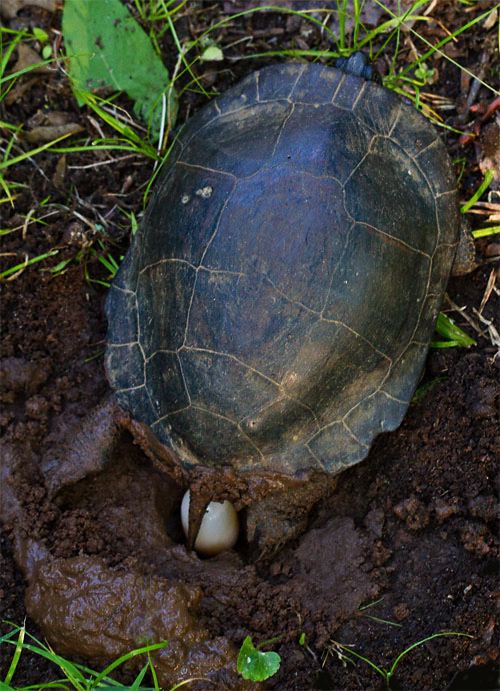

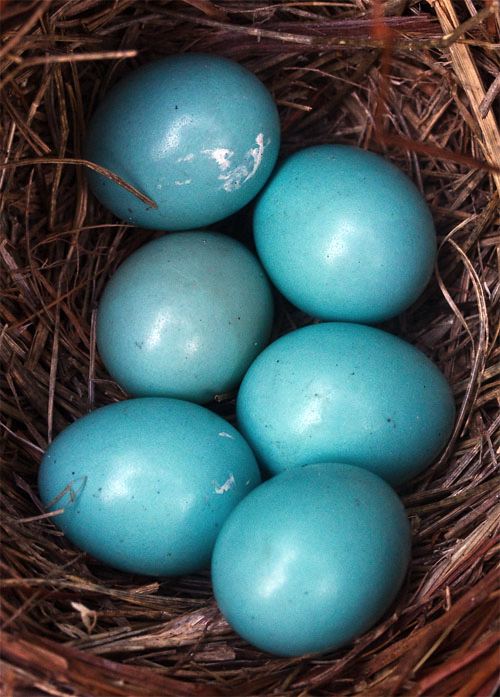
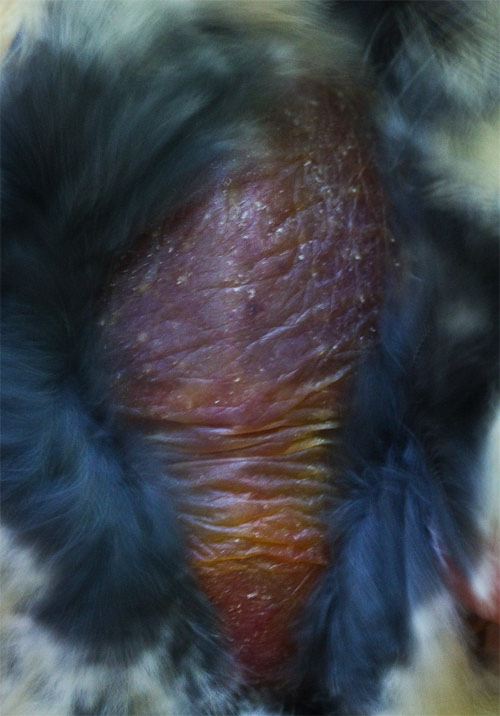
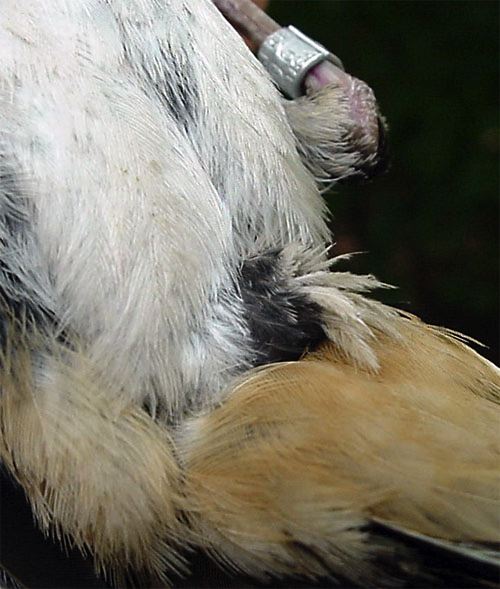

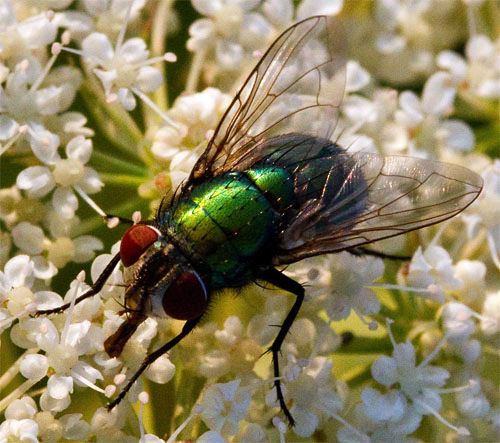
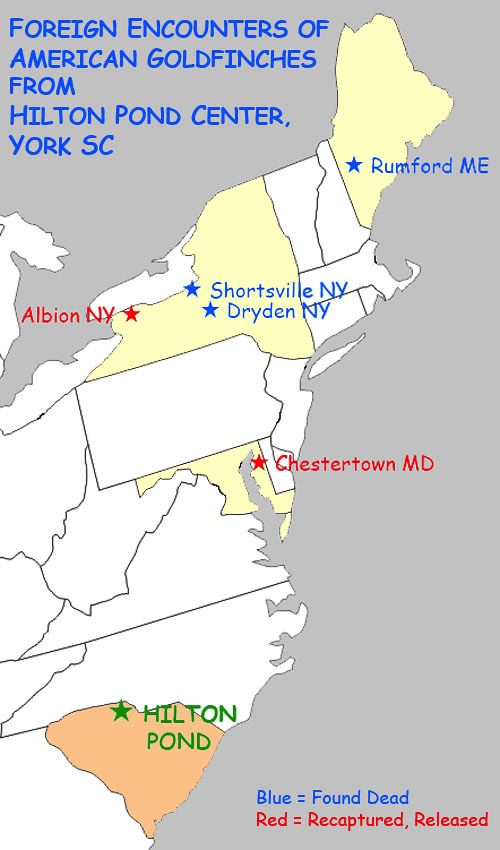


 Please report your
Please report your